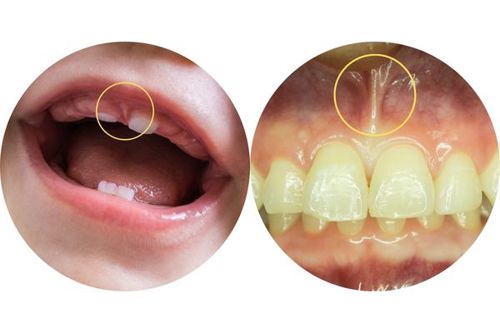
A tongue-tie refers to a visually tight/restricted lingual frenum that is causing difficulties in performing certain actions that require the use of the tongue, such as breastfeeding.
What is a lingual frenum?
The lingual frenum refers to the fold of soft tissue located under the tongue, joining it to the base of the mouth. Everybody has a lingual frenum and they will all appear different to one another.

There are a number of frena present in the mouth. Frena is the plural of frenum. For example, the labial (lip) frenum that can be seen when lifting the upper and lower lips. Frena are present from birth.

Labial frena highlighted by yellow circles.
What is a tongue-tie?
A tongue-tie refers to the restricted movement of the tongue causing functional limitations, accompanied by a visually restricted lingual frenum
Ankyloglossia is the medical term for a tongue-tie.
Tongue-tie is reported to be present in 4% to 11% of newborns. The exact cause of tongue-tie is not known. Research shows that genetics may play a role in its development.
Posterior tongue-tie
There is a lack of scientific evidence to support the medical diagnosis of a 'posterior' tongue-tie.
The Australian Dental Association's Ankyloglossia and Oral Frena Consensus Statement 2020 reports that the use of the term ‘posterior’ tongue-tie can result in a normal lingual frenum being classified as abnormal. This statement reports that ‘posterior’ tongue-tie should not be used as a medical diagnosis.
What functions can a tongue-tie affect?
Tongue-ties in infants have been shown to be associated with breastfeeding issues.
Some people may experience issues with speech. But research does not show that tongue-ties commonly affect speech or its development.
How is a tongue-tie diagnosed?
Tongue-tie diagnosis should not be based only on what the lingual frenum looks like. For a tongue-tie diagnosis, the lingual frenum must look tight/restricted but the person must also have difficulty in performing functions that use the tongue. If there is no trouble using the tongue, the lingual frenum should be considered normal.
If you think your child may have a tongue-tie, the health professional to first seek advice from depends on what issue your child is experiencing. They will take a history and assess your child's tongue function. They can provide advice on whether the problem is impacted by your child's tongue function.
For example, if you are experiencing breastfeeding problems, an International Board-Certified Lactation Consultant (IBCLC), midwife or maternal child health nurse can provide a breastfeeding assessment and recommendations. If you are concerned about your baby moving from soft to hard foods or their speech development, it is best to seek advice from a speech pathologist.
How is a tongue-tie treated?
It is best to try non-surgical treatment methods before looking into surgical treatment for a tongue-tie.
Examples of non-surgical treatment methods for breastfeeding issues can include:
- Advice on positioning.
- Latch optimisation.
- Feed frequency.
- Supporting mothers to maintain milk supply.
- Use of external tools such as nipple shields or supplementary nursing systems.
If you and your child are still experiencing problems, surgery may be explored as an option.
Surgical treatment
Surgical treatment of the lingual frenum may be suitable after:
- Diagnosis of tongue-tie by an appropriately trained health professional using appropriate diagnostic assessments;
- Non-surgical treatment has not been successful; and
- Full informed consent is obtained.
It is not recommended that surgery is completed based on concerns about future problems with the tongue’s function.
Surgical treatments can include a frenectomy, frenotomy or frenuloplasty. All of these treatments are based on cutting the lingual frenum to try and create a better motion for the tongue. Although it may see like a simple procedure, all surgical procedures come with risks. This includes surgical treatment for tongue-tie.
The surgeon treating your child will advise you of the risks associated with the treatment before it is done. There is no guarantee that surgery will improve the tongue’s function. It is possible that following surgery, issues may become worse or new issues may develop.
Tongue-tie treatment for adults
Surgical treatment of a tongue-tie for adults is an elective treatment. The decision to undergo treatment should be made between the adult patient and their dentist.
Possible surgical complications
Acute complications can include:
- Deep ulcers
- Bleeding
- Haematomas
- Airway blockage
- Swelling
- Restricted tongue movement
- Tissue damage or injury that is caused by the treating health professional
Chronic complications can include:
- Development of scar tissue that can affect the tongue’s movement
- Injuries affecting the glands that create saliva
- Oral aversion, where a baby or child has a sensitivity or fear of food or drink entering the mouth
- Ranula
- Tongue paraesthesia
- Infection
Will a visually tight or restricted lingual frenum cause future problems?
If your infant or child has a visually tight/restricted lingual frenum but no issues using their tongue, the lingual frenum should be considered normal. There is no way to know if someone with a lingual frenum that looks tight will develop issues in the future. If your infant or child does not currently have any issues, surgical treatment is not recommended. Surgical treatment can always be completed in the future if your child has issues with their tongue's function.
More information
For more information on tongue-ties, see the ADA's Ankyloglossia Consensus Statement.


